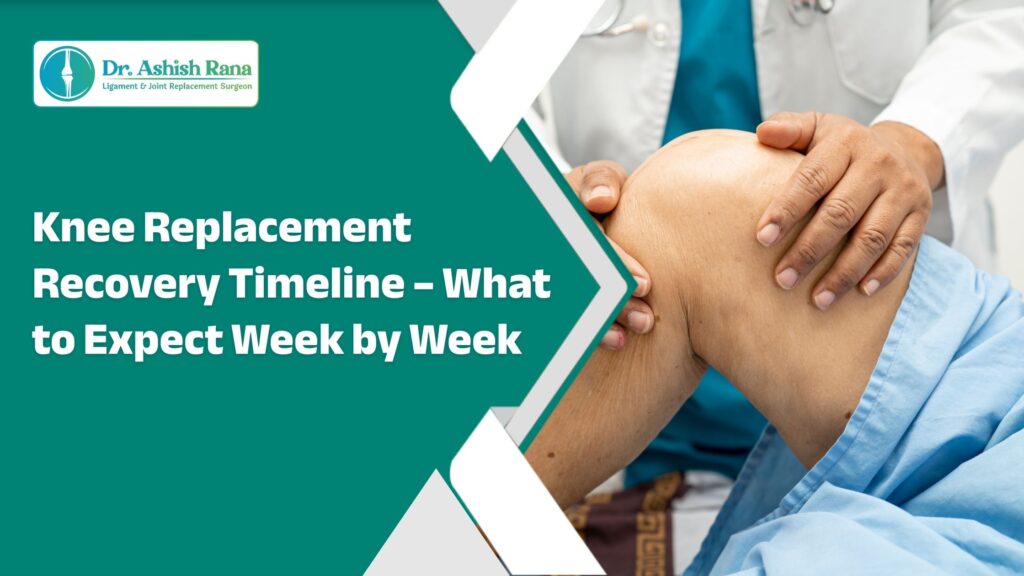Introduction
you only had a replacement surgery of your knee – or planned to do – you probably have a million questions that emerge. Here is the confident truth: With a little guidance and very patience, you will rise for stronger, stable progress than before. Each recovery is unique, but a widely shared week for the week is the most useful. And by choosing the Best Knee Replacement Surgeon In Jaipur, you have already laid a solid base for a smooth medical passage.
Let’s go through every week, so you know properly what’s around the corner.
Week 1: The First Few Days
The first week is mostly about quiet healing and careful pain control. Count on staying in the hospital for two to three nights. Pain meds, antibiotics, and the rehab team will feel like your new circle of support. Don’t be alarmed if your surgeon has you standing—crutch-assisted—within twenty-four hours; that’s a welcome sign. Moving gently and doing small ankle pumps and knee lifts are introduced right away to keep stiffness at bay.
Week 2: Settling In at Home
Once you get home, reality checks in. Your leg may still look a little colorful and puffy, but ice and gentle, doctor-approved moves are already making a difference. You’ll be able to shuffle small laps using a walker or a set of crutches. Picture it like getting behind the wheel for the first time—no highway speed yet, but you’re definitely on the road.
Weeks 3–4: Finding Your Groove
The clock is turning faster now. Physical therapy shifts from recommendation to routine, and you’ll feel it. Every session helps loosen the joint, dull the ache, and boost your walking confidence. A few stairs, with a firm hand on the railing or a partner, may start to feel possible.
When you look at the calendar on the last Sunday of month four, there’s a good chance you’ll be moving with only a light cane—or maybe even none at all. Hang on to that feeling of moving slow, because it’s still moving.
Weeks 5–6: Reclaiming Daily Life
The mirror is finally reflecting you. Discomfort takes the hint and fades away; bending and straightening your knee feel less like a contest and more like routine. You’ll start to enjoy longer walks without the “what’s that ache?” question drifting in. Cooking, folding a towel, or hopping in the passenger seat of the car for a quick errand is on the agenda.
Keep in mind, it’s a marathon, not a sprint. Keep up with your routine!
Weeks 7–8: Back to Daily Activities
Your knee’s feeling better, and you can move around with less bother. Most can go independently and cope with stairs with a light push. Inflammation can flare up from time to time, but this is not a big deal. Now’s a good time to add gentle light-strength stuff, like a few easy minutes on a stationary bike.
Weeks 9–10: Feeling Confident
Life looks different at this point. A few weeks ago, the tasks are on the side and out of a car, light homework, or drive a fast error-to-do doors are back on the list. You go lightly, sleep a little better, and your knees are very rare in your brain during the day.
Weeks 11–12: Almost There
On a three -month brand you will feel about 75-80% better. Strong knee, your range is widespread, and you also have to think of a mild swimming or cycle a simple bike.
Months 4–6: The Final Stretch
Things feel better, but the finish line is still a little way off. Your knee is still mending on the inside even though it looks and feels alright on the outside. Ongoing exercise and PT are the secret sauce that’ll help you finish regaining full strength and movement. By the end of six months, most folks feel nearly good as new.
Tips for a Smooth Recovery
Stick to rehabilitation agreements – no jump for any reason!
Regular glaze reduces inflammation and accelerates treatment.
Wrap your plate with protein; It is a large building block for improvement.
Don’t rush; Continue with the speed of your body – fail to the limit and respect it.
Keep your souls up; The recovery is as much about the mentality as it is about speed.
Conclusion
Knee replacement recovery can feel long, but if you break it down week by week, it’s completely doable. Each tiny motion—literally—steers you closer to life without the old, gnawing pain. With the right cheer squad, a consistent routine, and your surgical team guiding you, you’ll soon step into days that pain can no longer interrupt.
And having the Orthopedic Doctor in Jaipur along for the entire ride is a game changer for safety and smooth healing.
FAQs
- When will I walk normally after the surgery?
Most folks are walking with a cane or walker in 4 to 6 weeks and are usually off support by 8 weeks.
- Will the surgery hurt?
There’s some stiffness and soreness at first, but smart pain management and consistent rehab make it much lighter.
- When can I get behind the wheel?
Most people can drive again safely in 6 to 8 weeks, once control of the new knee is steady and reflexes are sharp again.
- Climbing stairs after knee replacement is certainly possible,
though you’ll want a bit of help at the start. By the 6-to-8 week mark, however, many people find they can handle stairs with much less hassle.
- Light sports can typically return by about three months,
and more demanding activities usually come back by six months or sometimes a little later, depending on how your recovery is going.


